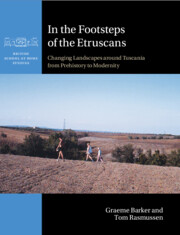Book contents
- In the Footsteps of the Etruscans
- British School at Rome Studies
- In the Footsteps of the Etruscans
- Copyright page
- Dedication
- Contents
- Figures
- Tables
- Contributors
- Preface and Acknowledgements
- 1 The Tuscania Archaeological Survey: Rationale, Aims and Objectives
- 2 Methodologies
- 3 The Natural Landscape and Its Evolution
- 4 Prehistoric Landscapes
- 5 Etruscan Urbanization, c. 700–300 bc
- 6 ‘Romanization’: The Roman Republican Period, c. 300–30 bc
- 7 The Roman Imperial and Late Antique Periods, c. 30 bc–c. ad 700
- 8 Incastellamento and Its Aftermath: Medieval and Modern Landscapes, c. ad 700 to the Present
- 9 A Mediterranean Landscape from Prehistory to Modernity
- Book part
- Bibliography
- Index
3 - The Natural Landscape and Its Evolution
Published online by Cambridge University Press: 12 October 2023
- In the Footsteps of the Etruscans
- British School at Rome Studies
- In the Footsteps of the Etruscans
- Copyright page
- Dedication
- Contents
- Figures
- Tables
- Contributors
- Preface and Acknowledgements
- 1 The Tuscania Archaeological Survey: Rationale, Aims and Objectives
- 2 Methodologies
- 3 The Natural Landscape and Its Evolution
- 4 Prehistoric Landscapes
- 5 Etruscan Urbanization, c. 700–300 bc
- 6 ‘Romanization’: The Roman Republican Period, c. 300–30 bc
- 7 The Roman Imperial and Late Antique Periods, c. 30 bc–c. ad 700
- 8 Incastellamento and Its Aftermath: Medieval and Modern Landscapes, c. ad 700 to the Present
- 9 A Mediterranean Landscape from Prehistory to Modernity
- Book part
- Bibliography
- Index
Summary
No attempt to evaluate the longue durée of human settlement can ignore the environment as both a formative influence and as a cultural artefact. The environmental programme of the project collected data to complement the regional geomorphological and palynological record on patterns of landscape change in response to climate change and the influence of human activities. The geomorphological fieldwork focused on the catchment of the Marta river that flows from Lake Bolsena past Tuscania to the Tyrrhenian sea near Tarquinia. The Late Glacial environment c.15,000 years ago consisted of a steppe landscape.After a sedimentary hiatus in the Early and Mid Holocene, sediments started to be laid down again in the Later Etruscan period c.500-300 BC, reflecting the extensive nature of Etruscan agriculture.Significant human impacts began in the Roman Republican period. Then and during the Early/Mid Imperial periods the Marta and other rivers in the area were unstable braided and wandering gravel-bedded rivers quite unlike the modern rivers. Their dynamism largely reflected a colder wetter climate than today but also woodland clearance and increased arable cultivation.This combination pre-conditioned the landscape’s sensitivity to alluviation in the Late Medieval and Post Medieval periods.
Keywords
- Type
- Chapter
- Information
- In the Footsteps of the EtruscansChanging Landscapes around Tuscania from Prehistory to Modernity, pp. 61 - 84Publisher: Cambridge University PressPrint publication year: 2023

